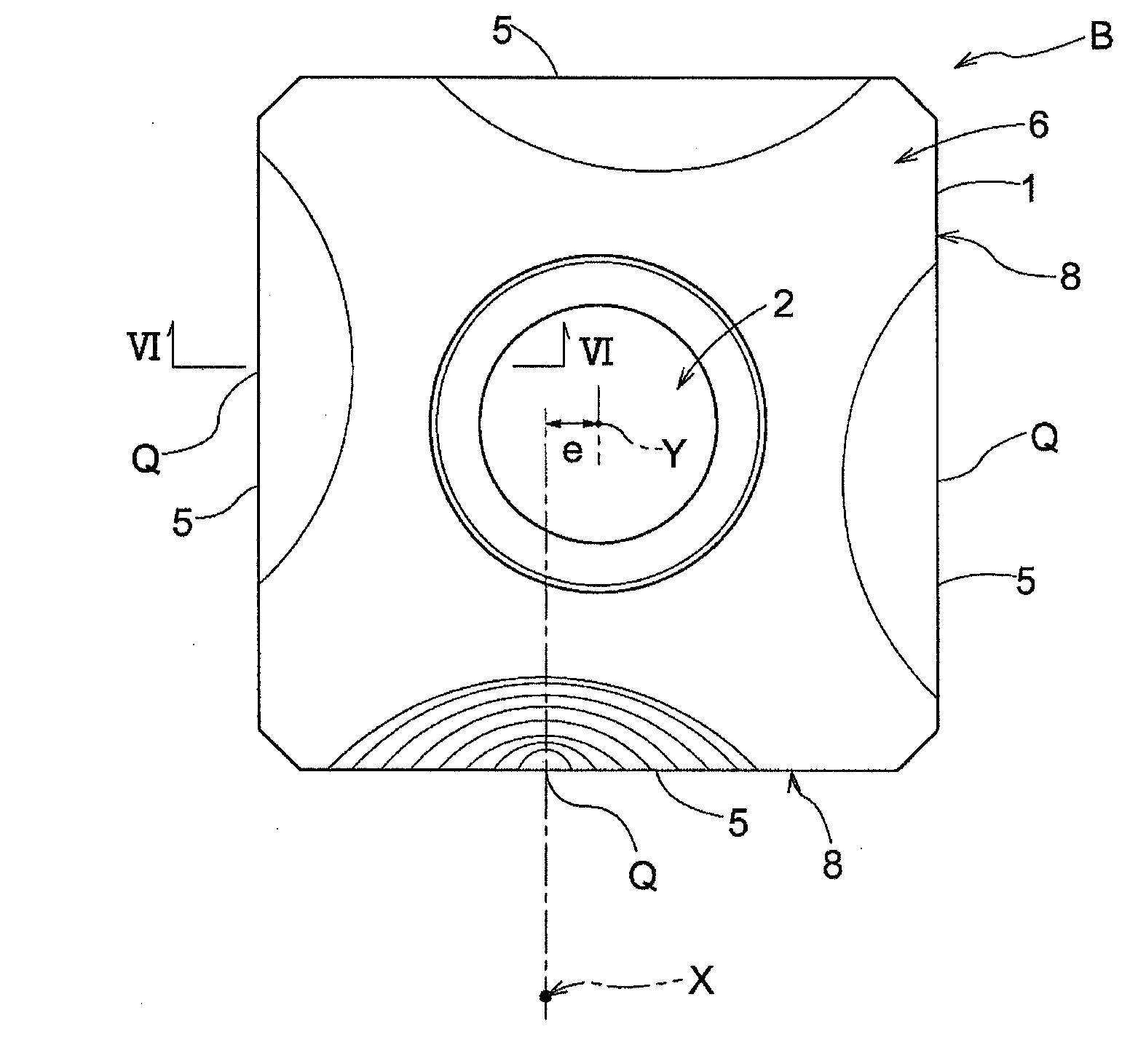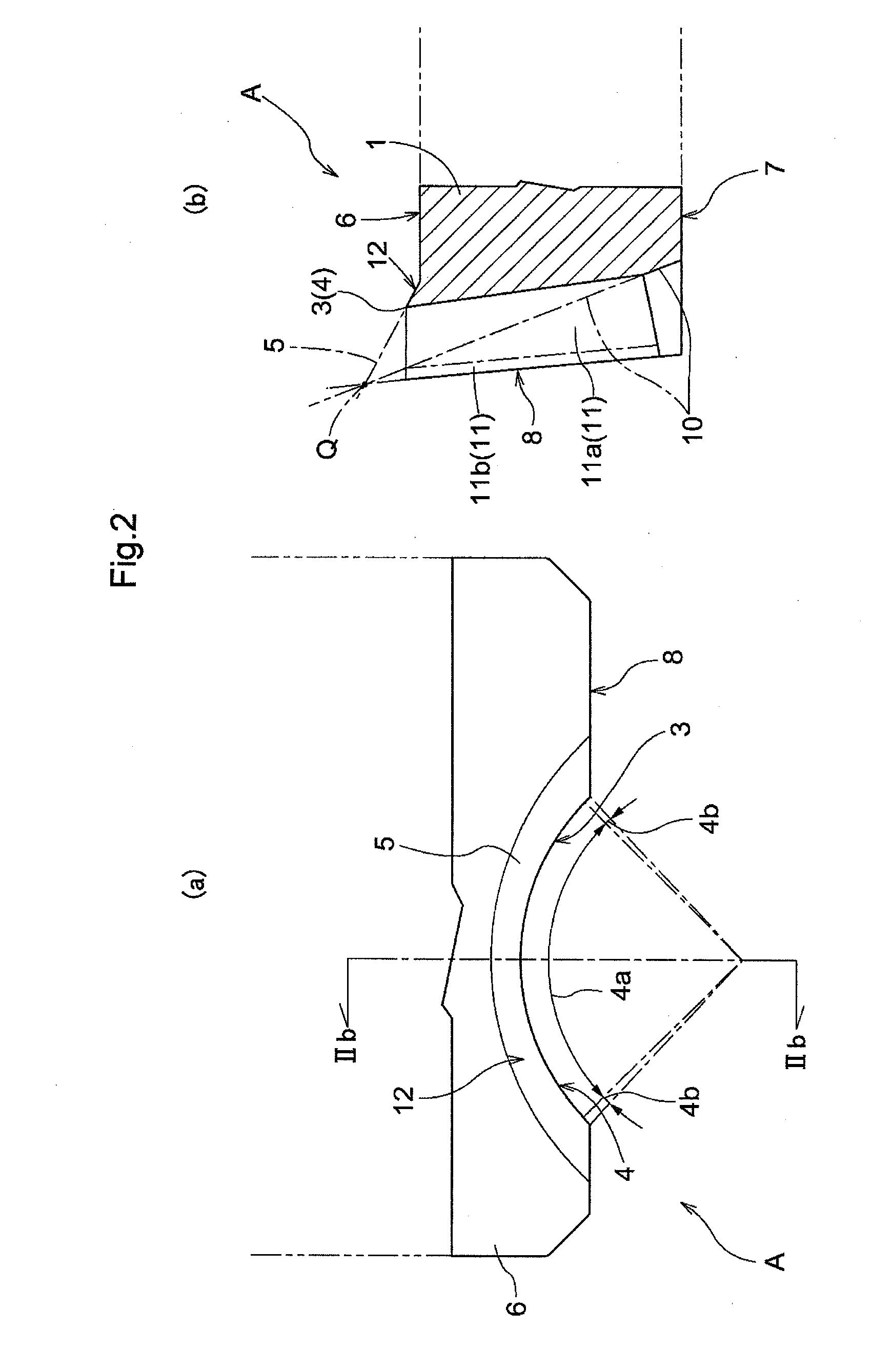Insert
a technology of inserts and inserts, applied in the field of inserts, can solve the problems of increasing the frequency of insert replacement during work, increasing the material cost, etc., and achieve the effects of reducing work cost, enhancing the strength of the cutting edge portion formed across the convex, and improving the work efficiency of cutting work
- Summary
- Abstract
- Description
- Claims
- Application Information
AI Technical Summary
Benefits of technology
Problems solved by technology
Method used
Image
Examples
first embodiment
[0036]FIGS. 1 and 2 show examples of an insert of the present invention. An insert A is fixed to a rotary cutting tool C for chamfering a corner of a material D to be cut into a round shape (curved shape) as shown in FIG. 7. The insert A is formed using hard metal, etc., for example.
[0037]The insert A has a base 1 formed into a generally square shape as viewed from top. One fixation hole 2 for fixing the base 1 to the rotary cutting tool C is provided in the center of the base 1. Four cutting edge portions 3 are provided at the sides of the base 1.
[0038]FIG. 1(a) shows an example where concave cutting edges 4 same in rounding size (curvature of the curved face) are provided at the sides of the base 1. FIG. 1(b) shows an example where cutting edges 4 different in rounding size from one another are formed at the sides of the base 1.
[0039]FIGS. 3 to 6 show a blank B before formation of the cutting edge portions 3. A convex 5 for formation of a rake face is formed in the thickness direc...
second embodiment
[0057]FIGS. 8 to 11 show an insert A of another embodiment.
[0058]In this embodiment, a plurality of convex s 5 for formation of the rake face are provided for each side of the base 1. For example, an outer convex 51 and an inner convex 52 are provided as the convex 5, and a step 16 is provided therebetween. FIGS. 8 and 9 show an example of forming the cutting edge 4 across the outer convex 51, and FIGS. 10 and 11 show an example of forming the cutting edge 4 across the inner convex 52. Two or more convex s may be provided.
[0059]Segmenting the convex in advance into different regions for formation of the cutting edge 4 as described above is convenient because such regions serve as a guide when the user works on the blank to form the cutting edge 4. For example, this not only makes it easy to select the curvature of the cutting edge 4, but also permits formation of the cutting edge 4 at a proper position with the contour lines serving as a guide when a grinding tool is pressed against...
third embodiment
[0060]FIGS. 12 to 14 show an insert A before formation of the cutting edges 4.
[0061]In this embodiment, the step 16 between the outer convex 51 and the inner convex 52 is formed from the top surface 6 of the base 1 itself. Therefore, the difference in the height from the top surface 6 between the outer convex 51 and the inner convex 52 is small.
[0062]The insert A of this embodiment is formed by casting and sintering, for example. The recess between the outer convex 51 and the inner convex 52 may be formed simultaneously with casting, etc., or only the recess may be formed by grinding, etc. after formation of the blank material for the insert A.
Other Embodiments
[0063]In the above embodiments, cutting edges having a single round (part of a circle) shape were described, but the cutting edges are not limited to this shape. For example, concave cutting edges formed by combining a plurality of round shapes may be formed.
PUM
| Property | Measurement | Unit |
|---|---|---|
| angle | aaaaa | aaaaa |
| shape | aaaaa | aaaaa |
| thickness | aaaaa | aaaaa |
Abstract
Description
Claims
Application Information
 Login to View More
Login to View More - R&D
- Intellectual Property
- Life Sciences
- Materials
- Tech Scout
- Unparalleled Data Quality
- Higher Quality Content
- 60% Fewer Hallucinations
Browse by: Latest US Patents, China's latest patents, Technical Efficacy Thesaurus, Application Domain, Technology Topic, Popular Technical Reports.
© 2025 PatSnap. All rights reserved.Legal|Privacy policy|Modern Slavery Act Transparency Statement|Sitemap|About US| Contact US: help@patsnap.com



